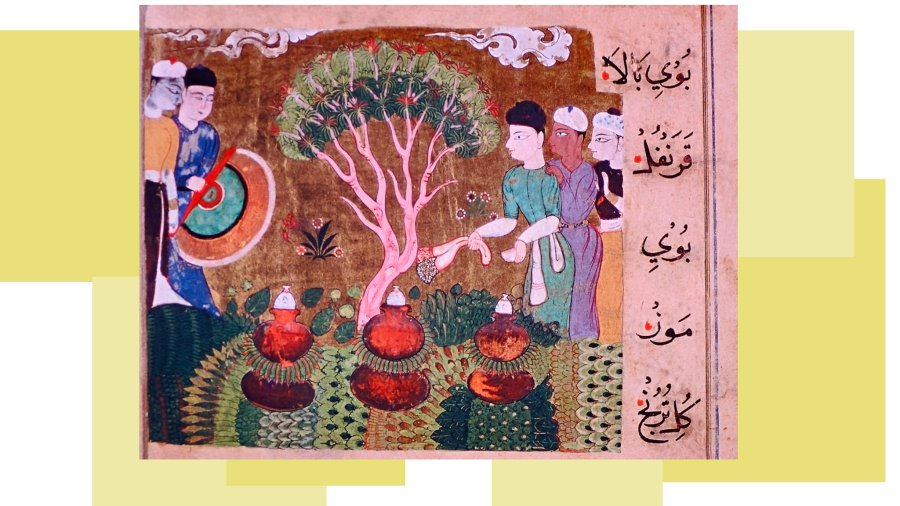[ad_1]
One of the greatest joys of a reader’s life is when one’s curiosity is led, like Alice in Wonderland, down a series of thrilling rabbit holes, without consulting anything as formal or stuffy as a reading plan. That’s how an idle search for medieval samosa recipes a few months ago introduced me to The Nimatnama, or The Book of Delights. This spectacular 15th-century illustrated manuscript, compiled for Sultan Ghiyas-ud-din Khalji (reign: 1469-1500), of the princely kingdom of Malwa in central India, is stuffed with recipes, pictures and guides to the daily enrichment of life.
I’ve always found the brisk cheerfulness of modern self-help books unconvincing; tidying up, practising yoga, thinking positive might be useful habits to cultivate but few of these books are truly life-enhancing. Yet there are plenty of historical guides that offer sound advice on leading a joyful and fulfilling life in tumultuous times. Take The Pillow Book, for example, a magnificent collection of lists, gossip and life hacks written in around 1,000AD by Sei Shonagon, a lady of the Japanese court. Or Chinese writer Lin Yutang’s wry 1937 guide, The Importance of Living, whose chapters include “The scamp as ideal†and “On tea and friendshipâ€. I’m drawn to texts that traverse the wide landscape of pleasure and humour over those that offer bristling plans of action.
Sultan Ghiyas-ud-din Khalji was a connoisseur of pleasure — his court included a vast harem of women — and among The Nimatnama’s recommendations are rice cooked in gold leaf, aphrodisiacs to uplift flagging spirits and sensuous perfumes. I came away with two recipes for delicately spiced samosa stuffings that turned out brilliantly. But there is humour too: the compendium begins with a delightful invocation to the King of Cockroaches, to deter them from devouring the manuscript’s pages. Throughout, the Sultan looks on benignly from the illustrated plates, supervising his cooks, dallying with female companions, his face less careworn than other medieval rulers.
On the face of it, Edmund de Waal’s Letters to Camondo, which is published next month, might have little in common with The Nimatnama. A writer and ceramicist, de Waal is perhaps best known for his 2010 memoir The Hare with Amber Eyes, which told the turbulent history of his European Jewish family through their prized collection of Japanese netsuke. Letters to Camondo continues the story through a series of fictional letters to Count Moïse de Camondo, who was a neighbour of de Waal’s family in Paris in the late 19th century. Like The Nimatnama, Letters to Camondo immerses you in another age — one as sharply torn with rifts and bigotry, political uncertainty and changing fortunes as our own — but also a time of grace and the deliberate cultivation of pleasure.
Through descriptions of Chester cake and porcelain, the arrangement of light and furniture, or the formal parks where Marcel Proust played as a boy, de Waal creates a dazzling picture of what it means to live graciously. “Everything is multiple, mirrored, paired, reflected, repeated. This great slow cadenced repetition of candelabra, vases, firedogs, pier glasses, tables, chairs and the gueÌridons — it all comes alive as you move through the space.†Tragedies happen; the young die before their time; and yet, those who survive find ways to continue, even to prosper, and find solace in art, beauty, grand dinners and intimate salons. What seems like indulgence or escapism might be simply another way to endure.
If both The Nimatnama and Letters to Camondo are monuments to aristocratic grandeur, there are plenty of books that make a case for pleasure and delight as a humble but still satisfying quest. Reading across journals, notebooks and essay collections on this theme, from the beloved Indian author Ruskin Bond’s guide to mountain life, A Book of Simple Living, to the Japanese writer Junichiro Tanizaki’s timeless meditation on beauty, In Praise of Shadows I noticed how my attention was being gently directed to the value of recording deep and abiding pleasures and of savouring fleeting emotions and encounters. More than any of the prescribed reading lists that popped up throughout 2020, this dive into books of delight was proving to be a sturdy lifeline.
It’s perhaps no surprise, then, that The Book of Delights by the American poet Ross Gay has been a recent bestseller. A couple of years ago, Gay set himself a light-hearted challenge: he would write “a delight a day†for a year, and he would write them swiftly and by hand. Subjects range from flowers stuck in a pavement crack to the pleasure of using air quotes recklessly, but also touch on the challenges of racial tension and other anxieties: noting, for instance, the sense of reassurance, fellowship and belonging that can be conveyed in a flash of eye contact between two people.
Reflecting on the project, Gay says that he has learnt there might be such a thing as a “delight muscle†— the more he studied the subject, the more it gave back. “I felt my life to be more full of delight,†Gay writes in his short, thoughtful book. “Not without sorrow or fear or pain or loss. But more full of delight.â€
Join our online book group on Facebook at FT Books Café
[ad_2]
Source link





